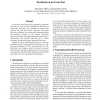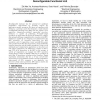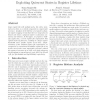54 search results - page 6 / 11 » An Instruction Throughput Model of Superscalar Processors |
CJ
2006
13 years 7 months ago
2006
Most microprocessor chips today use an out-of-order instruction execution mechanism. This mechanism allows superscalar processors to extract reasonably high levels of instruction ...
ISCA
2003
IEEE
14 years 27 days ago
2003
IEEE
As processor back-ends get more aggressive, front-ends will have to scale as well. Although the back-ends of superscalar processors have continued to become more parallel, the fro...
ISCA
2000
IEEE
14 years 5 hour ago
2000
IEEE
Reconfigurable hardware has the potential for significant performance improvements by providing support for application−specific operations. We report our experience with Chimae...
ICCD
2004
IEEE
14 years 4 months ago
2004
IEEE
Large register file with multiple ports, but with a minimal access time, is a critical component in a superscalar processor. Analysis of the lifetime of a logical to physical reg...
ISLPED
2006
ACM
14 years 1 months ago
2006
ACM
Today’s superscalar microprocessors use large, heavily-ported physical register files (RFs) to increase the instruction throughput. The high complexity and power dissipation of ...



